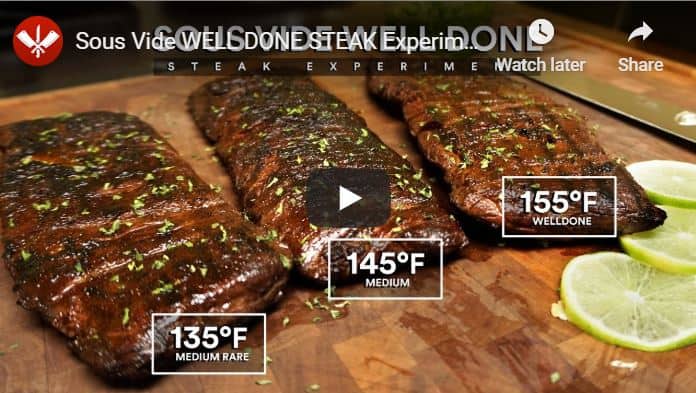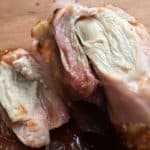The skirt and the flank are two great steaks. While they have a few things in common they are not the same cut of meat and have significant differences in grain structure, shape and fat content which means that they cook up a little differently.
If you are trying to figure out which of these steaks is better then the answer is that it depends on how you want to serve them.

Let’s take a closer look at the Skirt vs Flank comparison and see what makes them different.
Where Do The Flank and Skirt Come From?
The flank steak comes from the abdominal area of a steer, specifically the Flank section, and is typically sold as an entire muscle. A flank steak will typically weigh between 1.5 and 2.5 pounds.
The skirt steak also comes from the belly of the steer, starting in the Plate section and extending into the Chuck. The skirt is actually the diaphragm of the steer. There is an “inside skirt” and an “outside skirt” but there really isn’t much difference between them.

There is also a third steak that comes from the abdominal section, the bavette, that is my favorite of the three. While all three of these steaks are different, the bavette and skirt are excellent flank steak substitutes.
Here is an awesome video that shows exactly where the flank, skirt and bavette comes from. Watch along as the butcher harvests each of these beautiful steaks.
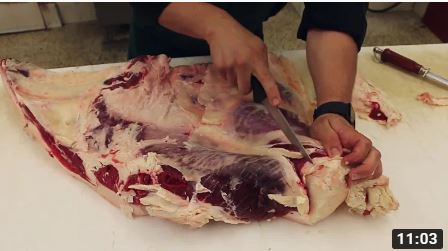 The flatness of the flank steak often causes people to confuse it with a flat iron steak. The flank is a completely different cut than the flat iron as the flat iron is incredibly tender steak that comes from the chuck subprimal.
The flatness of the flank steak often causes people to confuse it with a flat iron steak. The flank is a completely different cut than the flat iron as the flat iron is incredibly tender steak that comes from the chuck subprimal.
The flank and skirt are almost always less expensive than ribeyes and are great value cuts.
Differences in Grain Structure
All three steaks from this section of beef (flank, skirt, bavette) have clearly defined grain structures. The fibers are long and run the entire length of the steak in a single direction. For all of these steaks slicing against the grain is absolutely critical. There is an important difference in the grain structure that is worth noting.
Here is a look at a flank steak. You can see that the muscle fibers are tightly bound together.
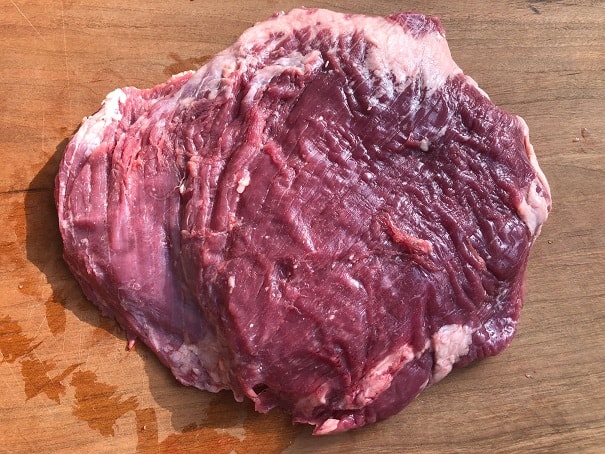
Here is a look at a skirt steak. You can see little gaps between some of the muscle fibers.

The muscle fibers on the skirt are more “open and loose” compared to the fibers on the flank. This means that the skirt can soak up marinades a whole lot better than the flank. The difference is so profound that, unless you work the flank over with a picard, there isn’t much point in marinating a flank as the flavors will barely penetrate the surface.
Which Steak Is Better?
Which steak is better depends upon how you plan to cook and serve them.
Flank Is Healthier
According to the National Cattlemen’s Beef Association the flank has fewer calories and less saturated fat than the skirt.
- A serving of flank steak has 160 calories and 2.6 grams of saturated fat.
- A serving of skirt steak has 200 calories and 3.6 grams of saturated fat.
If you want big, bold beefy flavor but want to stay lean then the flank is the steak for you.
The leanness of the flank makes it one of my favorite steaks for creating a steak platter when I have guests over. I like to cook a couple steaks, slice them thin and pile them onto a serving tray for an impressive display. When I do this with a fatty cut like ribeye I have watched guests pick their way around the fatty pieces. When I do this with flank everyone just dives right in!
Skirt Steak Is Better For Fajitas
The openness of the grain structure on skirt makes it better for fajitas for two reasons.
The skirt can really soak up a marinade making it easy to put a fajita flavor profile into the meat. You can make fajitas with flank but, since it does not soak up marinades very well, they will taste more like steak tacos than true fajitas.
The looseness also means that, when cut across the grain, slices of skirt are going to be more tender than flank. This is important for fajitas because you can take a clean bite without the entire slice of beef coming out.
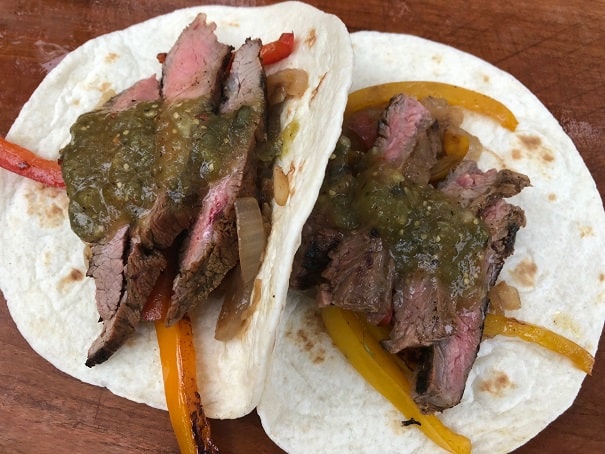
How to Cook These Steaks
There are two things that are absolutely critical to remember when you cook either of these steaks.
The first is that the steaks have a silverskin type membrane that helped keep the muscle fibers together on the steer. The membrane is usually removed when the animal is butchered but some shops get lazy and leave the membrane on. Always check and make sure the membrane has been removed and if not, then cut it off yourself. If you cook either of these steaks with the membrane still attached then it will be the chewiest steak you have ever eaten in your life.
The second thing to remember is to always slice these steaks against the grain for maximum tenderness. For some steaks like a ribeye or sirloin slicing against the grain isn’t important because of how tender they are. This is not the case for the flank or skirt and slicing across the grain is critical.
Grilling
My favorite way of cooking either of these steaks is grilling them over charcoal. Since both of these steaks are thin, flat cuts there is no need to mess around with indirect heat or reverse searing. I go with direct high heat using a set of GrillGrate panels to put down some grill marks. A guy has to have some fun 🙂
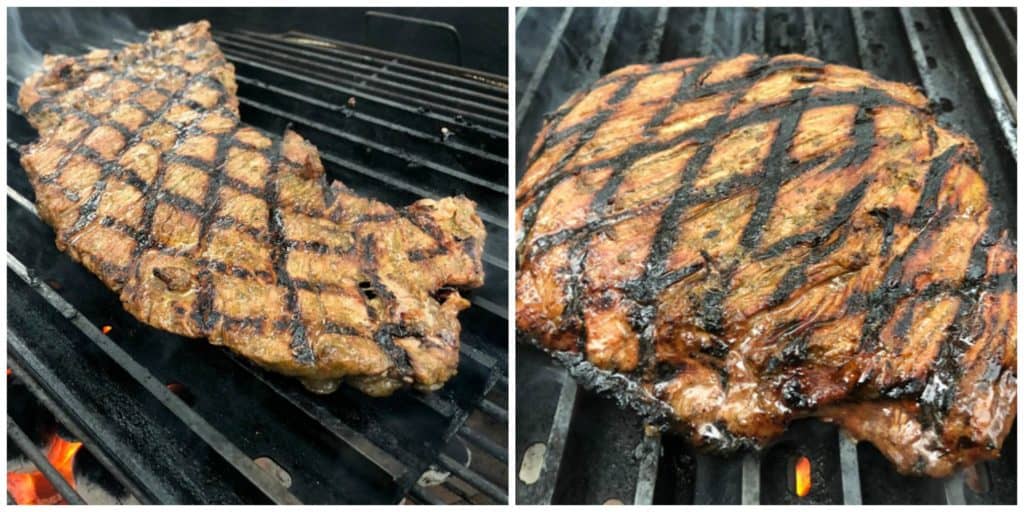
The skirt is a thinner steak than the flank so it grills faster. I will typically grill a skirt steak for three minutes per side while a flank will go for five minutes per side.
I always shoot for an internal temperature 130F (Medium Rare) but that can be tricky. The skirt is so thin that it is hard to get my thermometer exactly where I want it. This is especially true when working over scorching hot charcoal and my fingers start burning!
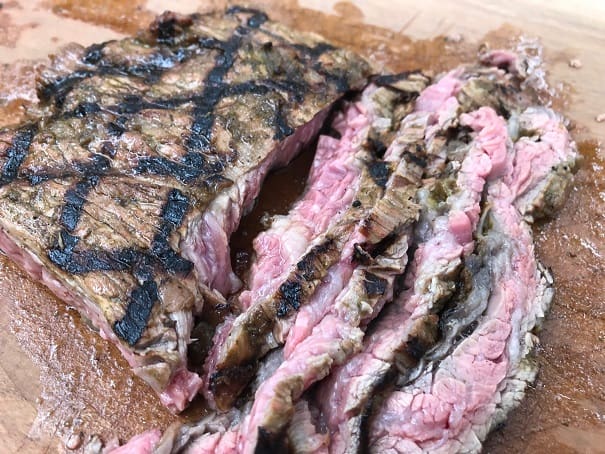
Sous Vide
Both cuts of meat can be cooked by Sous Vide but I believe the thicker flank steak benefits more from the long simmer in the water bath then the skirt.
To cook the flank by Sous Vide you will need to season the steak with salt and pepper, vacuum seal it in a food grade plastic bag and simmer the steak at 135F for two hours.
After two hours remove the steak from the plastic bag, pat dry with paper towels and sear in a cast iron skillet for about one minute per side to get a beautiful crust.
I was searching YouTube for information on cooking a skirt steak by Sous Vide and came across an interesting video. The video is a comparison of three skirt steaks cooked to different levels of doneness. The takeaway is that while Medium Rare was the best, the skirt can handle being cooked to Well Done and still be a pretty nice steak.
On The Stove Top
Either of these steaks can be cooked in a skillet on the stove but they will not be as great as when they are grilled over charcoal.
When I cook steaks on the stove I always use a cast iron skillet. Put a little peanut oil or beef suet in the pan and heat the skillet until the fat just starts to smoke. Add the steak and flip every minute. Flipping the steak every minute helps prevent overcooking the outside of the steak while still developing a tasty crust.
A typical flank steak should be Medium Rare in about 12 minutes while the thinner skirt should be done after about 10 minutes. Use a digital thermometer to determine when the steak reaches 135F.
Stir Fry
Both steaks are great for use in a stir fry! The video below, from the Certified Angus Beef brand, shows an elegantly simple stir fry of beef and green onions. They are using a flank steak and slicing it super thin before cooking. Since the steak is cut so thin this is one of the few times that marinating flank steak really adds serious flavor.
Another classic stir fry you could use these steaks for is beef and broccoli with button mushrooms!

